The global data lakehouse market is estimated to grow from USD 14 billion in 2025 to approximately USD 112.6 billion by 2035, recording an absolute increase of USD 98.64 billion over the forecast period. This translates into a total growth of 705.6%, with the market forecast to expand at a compound annual growth rate (CAGR) of 23.2% between 2025 and 2035. The overall market size is expected to grow by nearly 8.06X during the same period, supported by increasing demand for unified data analytics platforms, rising adoption of cloud-native architectures, and growing focus on real-time data processing and machine learning integration.
Between 2025 and 2030, the data lakehouse market is projected to expand from USD 14 billion to USD 42.35 billion, resulting in a value increase of USD 28.37 billion, which represents 28.8% of the total forecast growth for the decade. This phase of growth will be shaped by rising demand for unified data platforms that combine data lake flexibility with data warehouse performance, increasing adoption of cloud-native solutions, and growing integration of artificial intelligence and machine learning capabilities. Technology companies are expanding their data lakehouse portfolios to address the growing demand for scalable, cost-effective data analytics solutions.
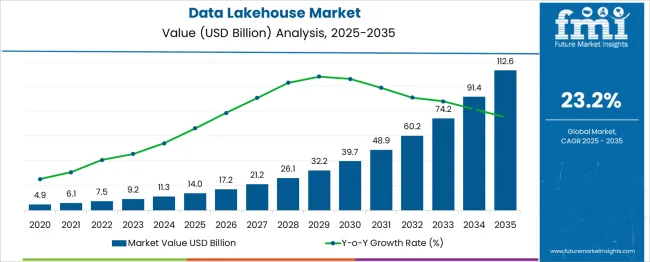
| Metric | Value |
| Estimated Value in (2025E) | USD 14 billion |
| Forecast Value in (2035F) | USD 112.6 billion |
| Forecast CAGR (2025 to 2035) | 23.2% |
From 2030 to 2035, the market is forecast to grow from USD 42.35 billion to USD 112.6 billion, adding another USD 70.27 billion, which constitutes 71.2% of the overall ten-year expansion. This period is expected to be characterized by widespread adoption of serverless architectures, integration of advanced analytics and AI/ML capabilities, and development of industry-specific data lakehouse solutions. The growing emphasis on data democratization and self-service analytics will drive demand for user-friendly data lakehouse platforms with enhanced performance and governance features.
Between 2020 and 2025, the data lakehouse market experienced robust expansion, driven by increasing recognition of traditional data architecture limitations and growing demand for unified analytics platforms. The market developed as enterprises realized the need for solutions that could handle both structured and unstructured data while providing warehouse-like performance. Cloud adoption acceleration and the rise of big data analytics began emphasizing the importance of flexible, scalable data platforms in digital transformation initiatives.
Market expansion is being supported by the increasing enterprise demand for unified data platforms that eliminate the complexity of managing separate data lakes and data warehouses. Modern organizations are increasingly focused on breaking down data silos and enabling real-time analytics capabilities that can support both operational and analytical workloads. The data lakehouse architecture's ability to provide ACID transactions, schema enforcement, and governance while maintaining the flexibility and cost-effectiveness of data lakes makes it an attractive solution for enterprise data strategies.
The growing emphasis on artificial intelligence and machine learning is driving demand for data platforms that can seamlessly support both traditional analytics and advanced AI workloads. Organizations require solutions that can handle diverse data types, support real-time streaming, and provide the performance necessary for complex analytical queries. The rising influence of cloud-native architectures and the need for scalable, cost-effective data solutions is also contributing to increased adoption across different industries and organization sizes.
The market is segmented by component, organization size, application, deployment, end-use industry, and region. By component, the market is divided into solutions and services. Based on organization size, the market is categorized into large enterprises and small to medium enterprises (SMEs). In terms of application, the market is segmented into operations, finance, marketing, HR, and others. By deployment, the market is classified into cloud and on-premises. By end-use industry, the market is divided into retail & e-commerce, IT & telecom, healthcare, energy & utilities, BFSI, manufacturing, and others. Regionally, the market is divided into North America, Europe, East Asia, South Asia & Pacific, Latin America, and Middle East & Africa.
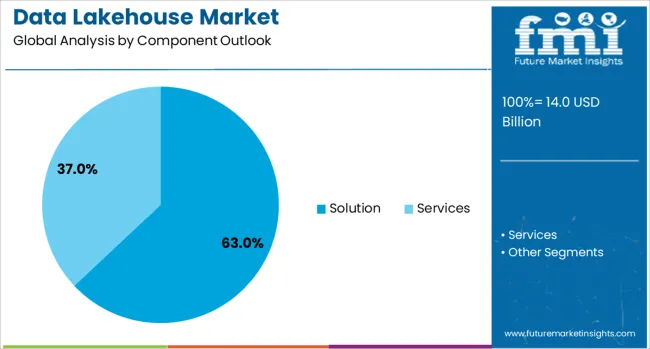
The solutions segment is projected to account for 63% of the data lakehouse market in 2025, reaffirming its position as the category's primary revenue driver. Organizations increasingly prioritize comprehensive platform solutions that provide unified data management, analytics capabilities, and governance features in integrated packages. The solutions segment encompasses data storage and management platforms, data integration and ETL tools, data governance frameworks, and analytics engines that form the core infrastructure of data lakehouse implementations.
This segment forms the foundation of most enterprise data strategies, as it represents the essential technology components required for successful data lakehouse deployments. Vendor focus on platform completeness and ongoing feature enhancement continue to strengthen the value proposition of integrated solutions. With organizations seeking to minimize complexity and accelerate time-to-value, comprehensive solutions align with both strategic and operational data management goals. The broad applicability across industries ensures sustained dominance, making solutions the central growth driver of data lakehouse market expansion.
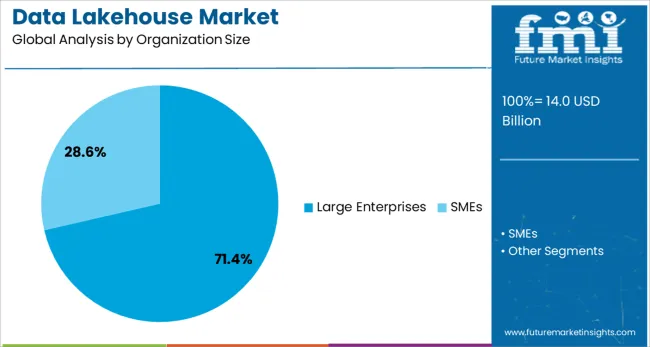
Large enterprises are projected to represent 71.4% of data lakehouse market demand in 2025, underscoring their role as the primary adopters of advanced data platform technologies. Large organizations possess the complex data requirements, technical resources, and financial capacity necessary for successful data lakehouse implementations. These enterprises typically manage vast volumes of structured and unstructured data from multiple sources, requiring sophisticated platforms that can handle scale, performance, and governance requirements.
The segment is supported by the increasing digital transformation initiatives among large enterprises and their need for unified data platforms that can support both operational and analytical workloads. Additionally, large enterprises are increasingly combining data lakehouse capabilities with existing data infrastructure, creating hybrid architectures that maximize ROI while enabling advanced analytics. As regulatory compliance and data governance requirements intensify, large enterprises will continue to dominate adoption, reinforcing their leadership position within the data lakehouse market.
The operations application segment is forecasted to contribute 30% of the data lakehouse market in 2025, reflecting the growing importance of real-time operational analytics in business decision-making. Organizations are increasingly leveraging data lakehouses to support operational processes such as supply chain optimization, inventory management, customer service, and production planning. This application area benefits from the data lakehouse's ability to provide both batch and real-time processing capabilities within a unified platform.
The segment's growth is driven by the increasing need for operational intelligence that can support automated decision-making and process optimization. Data lakehouses enable organizations to combine historical data with real-time streaming data to provide comprehensive operational insights. With the rise of Industry 4.0 and digital operations, operational applications serve as powerful differentiators, making them a critical driver of trust and value creation in the data lakehouse category.
The data lakehouse market is advancing rapidly due to increasing demand for unified data platforms and growing adoption of cloud-native architectures. However, the market faces challenges including technical complexity, skills shortage, and integration challenges with legacy systems. Innovation in serverless computing and automated data management continue to influence product development and market expansion patterns.
The growing adoption of cloud-native data platforms is enabling organizations to achieve better scalability, cost-effectiveness, and operational efficiency. Serverless computing models allow enterprises to focus on data analytics rather than infrastructure management while providing automatic scaling and pay-per-use pricing models. Cloud providers are continuously enhancing their data lakehouse offerings with managed services, automated optimization, and integrated AI/ML capabilities.
Modern data lakehouse platforms are incorporating advanced analytics capabilities, machine learning frameworks, and artificial intelligence tools to provide comprehensive data science environments. These integrations enable organizations to perform complex analytics, build predictive models, and deploy AI applications directly within the data lakehouse architecture. Advanced capabilities include automated data preparation, feature stores, model serving, and MLOps functionality that streamline the entire machine learning lifecycle.

| Country | CAGR (2025-2035) |
| India | 29% |
| China | 31.3% |
| Germany | 26.7% |
| France | 24.4% |
| UK | 22% |
| USA | 19.7% |
| Brazil | 17.4% |
The data lakehouse market is experiencing exceptional growth globally, with China leading at 31.32% market share through 2035, driven by massive investments in digital infrastructure, government initiatives supporting data-driven innovation, and rapid adoption among both technology companies and traditional enterprises. India follows closely with 29.0% growth, supported by expanding cloud adoption, growing data science capabilities, and increasing demand for cost-effective analytics solutions. Germany shows strong performance at 26.68%, emphasizing industrial IoT integration and manufacturing analytics. France records 24.36%, focusing on financial services digitalization and retail analytics transformation. The UK demonstrates 22.04% growth, prioritizing fintech innovation and regulatory technology solutions.
The report covers an in-depth analysis of 40+ countries; seven top-performing countries are highlighted below.
Revenue from data lakehouse solutions in China is projected to exhibit exceptional growth with a 31.3% market share through 2035, driven by unprecedented investment in digital infrastructure, government support for data-driven innovation, and rapid adoption across both technology leaders and traditional industries. The country's comprehensive digital transformation strategy and emphasis on artificial intelligence development are creating significant demand for unified data platforms that can support both operational and analytical workloads across diverse industry sectors.
Revenue from data lakehouse solutions in India is expanding at a 29% growth rate, supported by the country's expanding IT services industry, increasing digitalization across traditional sectors, and growing adoption of cloud-native data platforms. India's strong technical talent pool and cost-effective technology services are driving both domestic adoption and global service delivery capabilities in data lakehouse implementations.
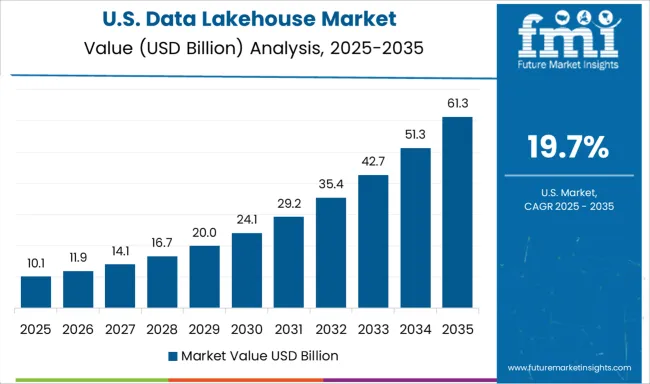
Demand for data lakehouse solutions in the USA is projected to grow at 19.7%, supported by enterprise focus on digital transformation, advanced analytics capabilities, and artificial intelligence integration. American organizations are increasingly prioritizing unified data platforms that can support both traditional analytics and emerging AI/ML workloads while providing enterprise-grade governance and security features.

Revenue from data lakehouse solutions in Germany is projected to grow at 26.7% through 2035, driven by the country's leadership in Industry 4.0 initiatives, manufacturing digitalization, and strong emphasis on data privacy and governance. German enterprises consistently demand high-quality, secure solutions that comply with strict regulatory requirements while providing advanced analytics capabilities.
Revenue from data lakehouse solutions in France is projected to grow at 24.4% through 2035, supported by digital transformation across financial services, retail innovation, and public sector modernization. French organizations value comprehensive data governance, advanced analytics capabilities, and integration with existing enterprise systems.
Revenue from data lakehouse solutions in the UK is projected to grow at 22% through 2035, supported by the country's advanced financial technology sector, growing adoption of regulatory technology solutions, and focus on data-driven innovation across traditional industries. British organizations prioritize platforms that can support both innovation and compliance requirements.
Revenue from data lakehouse solutions in Brazil is projected to grow at 17.4% through 2035, supported by accelerating digital transformation across traditional industries, growing cloud adoption, and increasing focus on data-driven decision making. Brazilian organizations are increasingly recognizing the value of unified data platforms for competitive advantage.
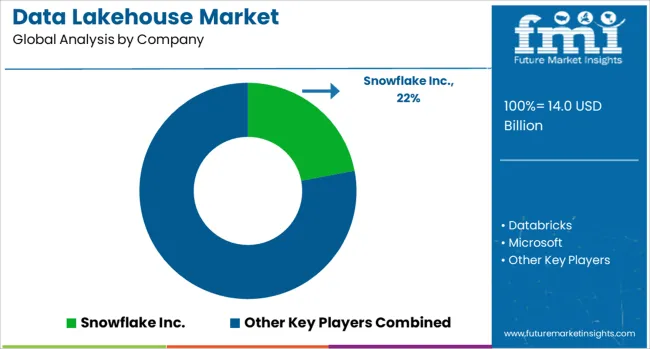
The data lakehouse market is characterized by competition among established cloud providers, specialized data platform companies, and emerging technology innovators. Companies are investing in advanced platform capabilities, artificial intelligence integration, industry-specific solutions, and comprehensive service offerings to deliver scalable, performant, and user-friendly data lakehouse solutions. Platform differentiation, ecosystem development, and customer success are central to strengthening market position and competitive advantage.
Snowflake Inc., USA-based, leads the market with 22.0% global value share, offering cloud-native data platform with built-in data lakehouse capabilities focusing on performance, scalability, and ease of use. Databricks, USA, provides comprehensive unified analytics platform combining data lakehouse architecture with collaborative data science and machine learning capabilities. Microsoft, USA, delivers integrated data lakehouse solutions through Azure cloud platform with emphasis on enterprise integration and hybrid capabilities. Amazon Web Services Inc., USA, offers comprehensive data lakehouse services through AWS platform with focus on scalability and ecosystem integration.
Google LLC, USA, provides cloud-native data lakehouse solutions with emphasis on artificial intelligence and machine learning integration. IBM Corporation, USA, offers enterprise-grade data lakehouse platforms with focus on hybrid cloud and industry-specific solutions. Cloudera Inc., USA, delivers comprehensive data platform with both on-premises and cloud deployment options. Teradata, USA, provides enterprise data warehouse and analytics platform with data lakehouse capabilities. Dremio and Starburst Data Inc. focus on query acceleration and data lakehouse optimization technologies.
| Items | Values |
|---|---|
| Quantitative Units (2025) | USD 14 billion |
| Component | Solutions, Services |
| Organization Size | Large Enterprises, SMEs |
| Application | Operations, Finance, Marketing, HR, Others |
| Deployment | Cloud, On-premises |
| End-Use Industry | Retail & E-commerce, IT & Telecom, Healthcare, Energy & Utilities, BFSI, Manufacturing, Others |
| Regions Covered | North America, Europe, East Asia, South Asia & Pacific, Latin America, Middle East & Africa |
| Countries Covered | United States, Canada, United Kingdom, Germany, France, China, Japan, South Korea, India, Brazil, Australia and 40+ countries |
| Key Companies Profiled | Snowflake Inc., Databricks, Microsoft, Amazon Web Services Inc., Google LLC, IBM Corporation, Cloudera Inc., Teradata, Dremio, and Starburst Data Inc. |
| Additional Attributes | Dollar sales by deployment model and industry vertical, regional adoption trends, competitive landscape, buyer preferences for cloud versus on-premises solutions, integration with AI/ML platforms, innovations in query optimization, serverless computing, and automated data management |
Component:
Organization Size:
Application:
Deployment:
End-Use Industry:
Region:
The global data lakehouse market is estimated to be valued at USD 14.0 billion in 2025.
The market size for the data lakehouse market is projected to reach USD 112.6 billion by 2035.
The data lakehouse market is expected to grow at a 23.2% CAGR between 2025 and 2035.
The key product types in data lakehouse market are solution, data storage & management, and others.
In terms of organization size, large enterprises segment to command 71.4% share in the data lakehouse market in 2025.






Full Research Suite comprises of:
Market outlook & trends analysis
Interviews & case studies
Strategic recommendations
Vendor profiles & capabilities analysis
5-year forecasts
8 regions and 60+ country-level data splits
Market segment data splits
12 months of continuous data updates
DELIVERED AS:
PDF EXCEL ONLINE
Data Center Market Forecast and Outlook 2025 to 2035
DataOps Platform Market Size and Share Forecast Outlook 2025 to 2035
Datacenter Infrastructure Services Market Size and Share Forecast Outlook 2025 to 2035
Data Acquisition Hardware Market Size and Share Forecast Outlook 2025 to 2035
Data Center Automatic Transfer Switches and Switchgears Market Size and Share Forecast Outlook 2025 to 2035
Data Discovery Market Size and Share Forecast Outlook 2025 to 2035
Data Masking Technology Market Size and Share Forecast Outlook 2025 to 2035
Data Centre Rack Server Market Size and Share Forecast Outlook 2025 to 2035
Data Center Power Management Industry Analysis in Western Europe Size and Share Forecast Outlook 2025 to 2035
Data Center Power Management Industry Analysis in Korea Size and Share Forecast Outlook 2025 to 2035
Data Center Liquid Cooling Market Size and Share Forecast Outlook 2025 to 2035
Data Business in Oil & Gas Market Size and Share Forecast Outlook 2025 to 2035
Data Centre Colocation Market Size and Share Forecast Outlook 2025 to 2035
Data Lake Market Size and Share Forecast Outlook 2025 to 2035
Data Center RFID Market Size and Share Forecast Outlook 2025 to 2035
Data Center Accelerator Market Size and Share Forecast Outlook 2025 to 2035
Data Center Outsourcing Market Size and Share Forecast Outlook 2025 to 2035
Data Center Refrigerant Market Size and Share Forecast Outlook 2025 to 2035
Data Center Fire Detection And Suppression Market Size and Share Forecast Outlook 2025 to 2035
Data Center Security Market Size and Share Forecast Outlook 2025 to 2035

Thank you!
You will receive an email from our Business Development Manager. Please be sure to check your SPAM/JUNK folder too.
Chat With
MaRIA